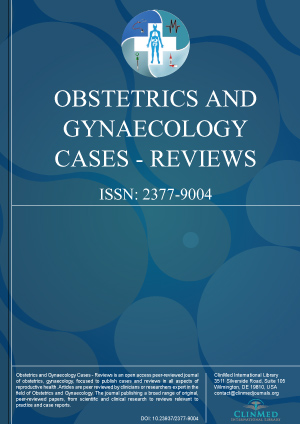Open Access DOI:10.23937/2377-9004/1410084
Cutaneous Horn of the Breast: A Rare Clinical Feature
Cedric Nadeau, David Desseauve and Emilie Laban
Article Type: Letter to Editor | First Published: April 11, 2016
A benign cutaneous horn was evocated as its base was thin but the diagnostic of a pre invasive intraepithelial dysplasia or squamous cell carcinoma of the skin had to be eliminated by histological examination. It looked like a solid elongated keratinized tumor connected to the skin by a thin bridge of pink/red regular skin (Figure 1 and Figure 2). No evidence of pre invasive skin lesion was found around. The patient had an excision of the lesion and its base under local anesthesia....
Open Access DOI:10.23937/2377-9004/1410082
Amniotic Fluid Embolism: Combined Treatment with Surgery and Extracorporeal Membrane Oxygenation Support - A Case Report
Arnon Wiznitzer, Rinat Gabbay-Benziv, Eran Altman, Dan Aravot and Philippe Biderman
Article Type: Case Report | First Published: March 28, 2016
A 42-year-old gravida 1, 40-weeks' gestation, presented with rupture of membranes in labor. Her history and prenatal care were unremarkable except for obesity. On physical examination, blood pressure was 156/91 mmHg with no other signs of pre-eclamsia. Due to non-progression at active labor, cesarean section was performed with extended "top-up" epidural and delivery of a healthy boy. Immediately after removal of the placenta, the patient reported chest pain, and became unresponsive. ECG (electro...
Open Access DOI:10.23937/2377-9004/1410081
An Idiopathic Case of Recurrent Spontaneous Ovarian Hyper Stimulation Syndrome
Alessandra Ainsworth, Zaraq Khan and Jani Jensen
Article Type: Case Report | First Published: March 26, 2016
We report a case of recurrent spontaneous ovarian hyperstimulation syndrome (OHSS). The patient presented at 8 weeks gestation. Due to severity of symptoms, the patient required both inpatient and outpatient management. Her symptoms resolved at 11 weeks gestation and the pregnancy was carried to term. Recurrent spontaneous OHSS is a rare and potentially morbid event. While most cases will eventually resolve, patients require careful diagnosis, surveillance, and supportive care....
Open Access DOI:10.23937/2377-9004/1410080
Urinary Incontinence as a Presenting Symptom of Bladder Cancer
Elena Vilar Gonzalez, Marta Perez de la Fuente, Enrique Gonzalez Diaz
Article Type: Case Report | First Published: March 25, 2016
Urinary incontinence is a very common complaint among women. We should think of potentially serious aetiologies when there is no response to empiric treatments, especially in postmenopausal women. We report a case of a 69 year old woman, referred to our pelvic floor unit with urinary incontinence and nocturia. After failing with anticholinergic treatment, a transvaginal ultrasound scanning shows an irregular solid lesion of 6 mm, which was diagnosed by further urological investigation as a trans...
Open Access DOI:10.23937/2377-9004/1410079
Postpartum Low Back Pain: It is not always What You Think
Melissa Corso, Diane Grondin and Carol Ann Weis
Article Type: Case Report | First Published: March 18, 2016
Postpartum back pain is common, with up to 75% of women experiencing back pain immediately following birth. This pain can be moderately to severely debilitating to the new mom, affecting activities of daily living such as caring for her new born, sleep patterns, and otherhousehold activities. However, all low back pain is not created equal and we document a case study with an unusual cause of postpartum back pain....
Open Access DOI:10.23937/2377-9004/1410078
Management of Pregnancy in a 24 Year Old Woman with Cervical Cancer in Resource Limited Settings: Case Report
Elichilia R Shao, George Semango, Kevin V Nandonde and Richard Rumanyika
Article Type: Case Report | First Published: March 03, 2016
Cervical cancer (CaCx) among immune competent young women is quite rare. Its management is a challenge especially in resource limited settings. We report management of pregnancy in a 24 year old woman with CaCx in Mwanza, Tanzania. A 24-year-old Tanzanian black women gravida three at 23 weeks of gestational age (GA) came to our hospital complaining of heavy vaginal bleeding mixed with foul smell discharges for about 2 months....
Open Access DOI:10.23937/2377-9004/1410077
An Internet Survey of Women with Unicornuate Uterus: Pregnancy Outcomes by Classification
Megan Trad
Article Type: Original Research | First Published: March 02, 2016
Unicornuate Uterus is a rare uterine anomaly that currently has very little scientific research on the reproductive possibilities and experiences of women with this condition, the majority of research is done on individual case studies. This article seeks to gain a wider look at all of the reproductive complications that women with Unicornuate uterus encounter, and also to investigate if there are statistically significant differences between subclasses in regards to reproductive outcomes....
Open Access DOI:10.23937/2377-9004/1410076
Investigating Alcohol Consumption during Pregnancy for the Prevention of Fetal Alcohol Spectrum Disorders (FASD)
Mauro Ceccanti, Daniela Fiorentino, Paola Ciolli, Giovanna Coriale, Marisa Patrizia Messina, Maria Concetta Marcella Scamporrino, Simona Solombrino, Marco Fiore and Valentina Carito
Article Type: Review Article | First Published: March 01, 2016
The term FASD (Fetal Alcohol Spectrum Disorders) is used to describe the entire spectrum of pathologies and disorders caused by alcohol exposure in uterus. Alcohol assumed in pregnancy passes directly through the placental barrier causing a broad range of symptoms whose severity can greatly vary in degree. The alcohol teratogenic effect may result in physical damage and specific facial anomalies, growth delays, neurological defects along with intellectual disabilities and behavioral problems....

